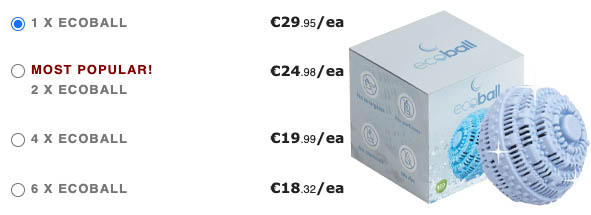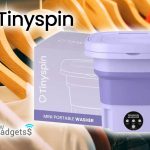Some gadgets promise to “change your life” and end up forgotten in a drawer. And then there are those that quietly become part of your routine. I tested Ecoball for four weeks in two very different setups: a city apartment with hard (chalky) water and a country house with a well and a top-loading washer.
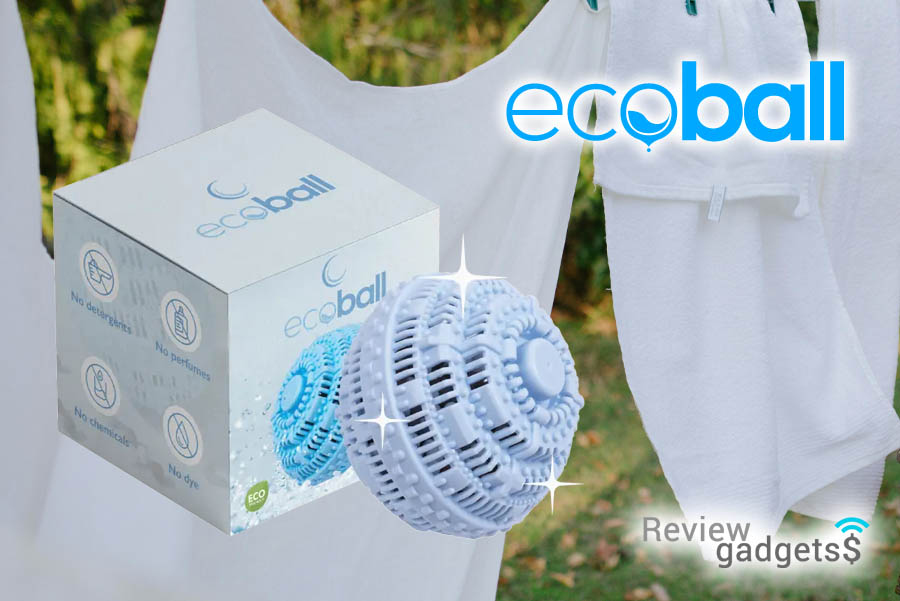
Between both households, I ran 36 loads: everyday wear, sports gear, towels, sheets, baby clothes, and a couple of “worst-case” items (tomato and grass stains). The goal: see whether a ceramic-bead laundry ball can replace (or drastically reduce) detergent, keep fabric soft without softener, and at the same time save money and plastic.
What is Ecoball?
Ecoball is a reusable laundry ball with a TPR shell and an interior filled with mineral ceramic beads. The maker claims up to 1,500 washes with consistent performance, color-coded fragrances (each version smells different), and compatibility with 99% of washing machines. The pitch is simple: wash without detergent, reduce limescale and drum odors, and extend the life of both your clothes and your washer.
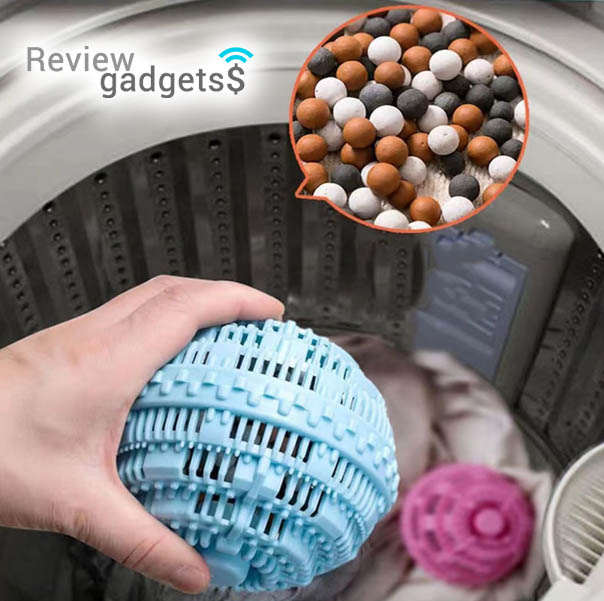
How is it supposed to work?
The idea behind these balls combines three effects:
- pH modulation and mild surfactancy: the ceramics release minerals that gently alkalize the water. A slightly higher pH helps lift greasy soil without conventional surfactants.
- Mechanical action: the ball itself agitates and separates fabrics, improving water flow through the fibers.
- Residue reduction: by skipping detergent (or using tiny doses on stubborn stains), you cut down on chemical buildup, which shows up on the door seal, drum, and filters.
No magic here: with tough stains (deep-set grease, wine, dried blood), it’s still wise to pre-treat or add a small dose of detergent (8–10 ml) on the occasional cycle. But for day-to-day laundry, the approach is “zero or near-zero detergent.”
Test setup
- Washers: 8 kg front loader (city, hard water ~30 °fH) and 10 kg top loader (rural).
- Programs: cotton 40 °C, mixed 30 °C, delicates cold, towels 60 °C.
- Load size: 5–7 kg actual, without overfilling.
- Comparison: week 1 with standard liquid detergent (baseline) vs. weeks 2–4 with Ecoball.
- Criteria: visual and smell cleanliness, feel/softness, odor control on sportswear, condition of drum and seals, consumption and savings.
Results: cleanliness and odors
Everyday clothes and sheets (30–40 °C)
With Ecoball, the clean feel matched detergent in virtually every “normal” load. Light tees, shirts, and underwear came out clean and fresh, with no residue. The scent depends on the ball’s color/aroma; the blue one I tried leaves a subtle fragrance, nothing overpowering. When air-drying indoors, I didn’t get the usual musty whiff you can get from over-soaping and leftover detergent.
Sportswear and microfibers
This is the toughest test because sweat odor gets trapped in polyester/elastane. Here, Ecoball performed better than expected: after 60 minutes at 40 °C, shirts were neutral—no heavy perfumes and no lingering smell. In two heavy spinning loads I added half a cup of white vinegar in the softener drawer: spotless result (and no, your clothes don’t smell like salad).
Towels at 60 °C
At 60 °C, Ecoball kept towels nicely plush (they don’t “collapse” the way they can with too much detergent + softener) and they dried faster. Bonus point: towels held their absorbency better by skipping softener.
Stubborn stains
- Tomato: a white tee kept a faint shadow after a cycle with only Ecoball. I repeated the test after pre-treating the ring with a little bar soap and it came out perfect.
- Grass: on a child’s trousers, 80–90% disappeared; the rest yielded with 8 ml of added liquid detergent.
Practical takeaway: for about 85–90% of loads, Ecoball works on its own; for the remaining 10–15% (stubborn spots), pre-treat or micro-dose detergent.
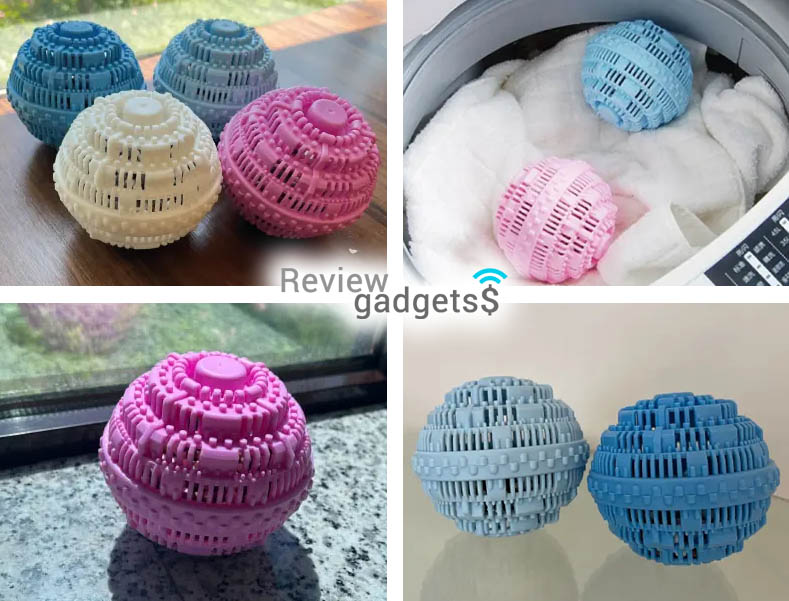
Softness, color, and fabric care
With softener and excess surfactants out of the equation, fibers keep their natural loft and don’t mat down. On cotton and fine knits I noticed it especially in the hand feel: less “waxy,” more authentic. Blacks tend to lose less dye over time when you avoid harsh detergents; after 5 comparative washes, the items cleaned with Ecoball had deeper blacks (to the naked eye). Technical garments (lycra, leggings) benefit from no-softener cycles as it prolongs elasticity.
Real savings: clear numbers
- Typical detergent cost: roughly €0.20–€0.40 per load (brand + real-world dosing, which is often more than needed).
- 1,500 “detergent-free” washes mean €300–€600 saved on soap alone. Skip softener as well (0.05–0.12 €/load) and add another €75–€180.
- Ecoball promo price: €29.95. Even if you supplement 10–15% of loads with 8–10 ml detergent, you still save well over €200–€400 across its estimated lifespan.
There’s also an “invisible” benefit: less chemical residue down the drain and less plastic from bottles over the year.
Washer impact: scale, seals, and drum
After four weeks:
- The door window and gasket showed less biofilm (that slimy layer that appears when you over-soap).
- In the hard-water apartment, no miracles against limescale (a periodic descaler is still a good idea), but things didn’t worsen and there were no drum odors, which is common when overdosing detergent.
- On quick 20–30 °C cycles, the “perfectly rinsed” feel is stronger precisely because there’s no foamy residue.
User experience and fragrances
Using it is literal: drop the ball in and press start. If you like to personalize, you can choose color/scent: the blue one left a clean, light freshness; I tried a fragrance-free version for baby clothes and it’s great if you want zero perfume. The ball doesn’t rattle or bang around; the shell feels solid and it didn’t bleed color or shed particles.
Durability and care
The manufacturer mentions up to 1,500 washes. In my experience, the key is to avoid overloading the drum and remove the ball for any drying cycle. One helpful habit: let Ecoball air-dry after each load so it can breathe and won’t trap moisture. If your washer is small (≤7 kg), one ball is enough; in large drums or very heavy loads, two give better coverage. Every 3–4 months, a maintenance cycle at 60 °C with no load keeps the drum pristine.
Price & Special Offers
Want to cut detergent use (almost to zero) without sacrificing a clean, fresh wash? Ecoball is currently available with a 50% discount and free shipping for just €29.95 instead of its regular price of €59.90 .
Activate the promotion via this link and start washing the easy way with a reusable ball that helps you save money, plastic, and chemical residue on every cycle.
Activate the 50% discount via this link
How to buy
- Check availability on the official website via this link.
- Choose how many Ecoballs you need (1 for small washers/standard loads; 2 for large drums or very heavy loads).
- Enter your shipping and payment details and complete your order securely.
- Enjoy the limited-time offer and get your Ecoball delivered to your door. Drop it in the drum… and wash!
Purchase Guarantee
For peace of mind, Ecoball includes a 30-day satisfaction guarantee. If you’re not convinced within that period, you can request a refund easily. The manufacturer also estimates up to 1,500 washes of useful life per unit under normal use.
What other users say
With more than 1,386 reviews and an average TrustScore of 4.7 out of 5, Ecoball has earned praise from families, athletes, and hard-water households looking to reduce (or eliminate) detergent without losing cleanliness or softness. Here are a few standouts:
Anna Parker ★★★★☆ (4.6/5)
“I live in a very hard-water area and towels felt rough even with softener. With Ecoball they’re fluffier and the drum smells neutral. For tough stains, a swipe of bar soap does the trick.”
Charles Bennett ★★★★☆ (4.7/5)
“I wash loads of cycling kit (polyester). At 40 °C everything comes out neutral—no heavy perfumes, no sweat smell. On really intense loads I add a splash of vinegar in the softener tray and it’s perfect.”
Laura Spencer ★★★★★ (4.9/5)
“For baby clothes I tried the fragrance-free version and I’m delighted: no irritation and no soapy residue. I’ve also cut plastic bottles to a minimum.”
Evan Mitchell ★★★★☆ (4.8/5)
“Day to day, I don’t miss detergent. If there’s tomato or grass, I pre-treat and, at most, add 8–10 ml of detergent. You can see the savings by month’s end.”
Martha Sanders ★★★★★ (4.9/5)
“I love how clothes feel more natural, without that ‘waxy’ touch. Darks hold their color better with repeated washes. And the ball doesn’t make noise or bang the drum.”
Take advantage of the promo and try Ecoball so that 85–90% of your loads come out spotless without detergent.
Who it’s for (and who it’s not)
Great fit if you:
- Wash everyday clothes, sportswear, towels and want to reduce or ditch detergent.
- Want to save money without sacrificing cleanliness or softness.
- Have sensitive skin or want to minimize perfumes and residues.
Not ideal if you:
- Do lots of heavily stained laundry (workshops, heavy hospitality) or require specific chemical disinfection.
- Want strong, lingering “premium softener” scents; here the fragrance is subtle by design.
Tester’s tips
- Very cold water plus heavy soil don’t mix well: use 30–40 °C as a baseline for everyday laundry.
- Pre-treat set stains (tomato, wine) with bar soap; it works.
- For intense sports loads, add a splash of vinegar in the softener compartment: it neutralizes odors without harming fibers.
- Don’t overfill: leave a fist’s width of space in the drum so Ecoball can circulate and do its mechanical part.
Activate the 50% discount via this link
Ecoball FAQ
Does it fully replace detergent?
For the vast majority of loads (85–90%), yes. For very tough stains (wine, dried blood, heavy grease), pre-treat or add a micro-dose of 8–10 ml of detergent.
Does it work in hard (chalky) water?
Yes. Its ceramic beads help slightly alkalize the water and improve soil release. Even so, in very hard-water areas it’s smart to run a maintenance cycle at 60 °C every 3–4 months or use a descaler periodically.
Do I need fabric softener?
No. With fewer chemical residues, textiles regain natural loft and keep absorbency (important for towels). If you prefer a silkier touch, try a splash of white vinegar in the softener drawer.
Does it leave a scent on clothes?
Ecoball aims for a neutral, fresh finish. Some versions include light fragrances (e.g., blue), and there’s also a fragrance-free option for sensitive skin or babywear.
Is it suitable for sports fabrics (polyester/elastane)?
Yes. It’s a demanding category due to sweat odors trapped in the fiber, but Ecoball delivers neutral results. On very intense loads, add vinegar as a softener to boost odor neutralization.
What’s the best wash temperature?
As a baseline, 30–40 °C. For towels and bedding, 60 °C occasionally improves hygiene and fluffiness. With very cold water plus heavy soil, results may drop.
How much can I load per cycle?
Aim for 5–7 kg actual and don’t overfill. Leave a “fist” of space so the ball can circulate and add its mechanical action. In large drums or very heavy loads, consider two Ecoballs.
Is it compatible with all washers?
The manufacturer states compatibility with 99% of washers (front and top loaders). Do not use in dryers and avoid programs that overheat if they include a drying phase.
How long does Ecoball actually last?
With normal use and without overloading the drum, the estimated lifespan is up to 1,500 washes. Let the ball air-dry after each cycle to avoid trapped moisture and extend performance.
Does it need maintenance?
Very little: simply air-dry it after use. Every 3–4 months, run a maintenance cycle at 60 °C with no load to keep the drum clean.
What about sensitive skin or baby clothes?
Choose the fragrance-free version. With fewer detergents and softeners, you reduce residues that may irritate skin. Always follow each garment’s care label.
Does it work with wool, silk, or delicates?
Yes, on delicate programs at low temperature. Place Ecoball in a mesh bag if you want to minimize friction even further. Always check the care label.
Is it septic-tank friendly?
Yes. By reducing surfactants and chemicals, it’s a gentler option for septic systems and the environment.
Can I combine it with powder or pods?
If needed, use a micro-dose (8–10 ml liquid or the smallest practical amount of powder). Avoid overdosing so you don’t lose the benefits of less residue and better rinsing.
Is it noisy or can it damage the drum?
The TPR shell is designed to cushion impacts and won’t create bothersome noise in balanced loads. Make sure you don’t overfill and that the ball can move freely.
What about tomato, wine, or grass stains?
They’re tenacious stains; the ideal is to pre-treat with bar soap and, if needed, add 8–10 ml of detergent. Usually they’re gone on the second cycle.
Do blacks fade with Ecoball?
By reducing harsh detergents and softeners, dark colors generally lose less dye over time and keep better depth.
Can I use it in a dishwasher or for other tasks?
No. Ecoball is designed exclusively for clothes washing machines.
Activate the promotion via this link
Conclusion
Ecoball won me over. Not by magic, but by consistency: in the great majority of real-world loads it cleans, neutralizes odors, keeps a pleasant feel, and reduces residue. For stubborn stains, a minimal assist (pre-treat or 8–10 ml detergent) finishes the job. Add the savings and the simplicity, and it makes sense in any home that washes daily and doesn’t want to rely on liters of chemicals.
Does it replace detergent forever? In my experience, for 85–90% of cases, yes. For the rest, it’s your first step before opening the bottle. At a promo price of €29.95 and with the promise of up to 1,500 washes, it’s the kind of accessory that goes from “eco curiosity” to a laundry staple.

